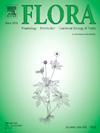The interactive effect of phenolics and microorganisms on Sphagnum spore viability and germination
IF 1.8
4区 生物学
Q3 ECOLOGY
引用次数: 0
Abstract
Allelopathic interactions with microorganisms likely govern plant community assembly, yet their effects on spore germination of Sphagnum, a critical carbon-sequestering genus, remains unknown. Using a hummock sphagnum, S. fuscum and a hollow sphagnum, S. squarrosum, we tested the effects of three phenolic compounds and their mixture common in peatland water on spore germination with and without microorganisms. Both individual and mixture of phenolic compounds increased Sphagnum spore viability. In presence of microorganisms, the viability of S. fuscum spores reduced from 44 to 36 % when cultivated in ultrapure water but it was increased from 52 to 63 % in peat water. Phenolic compounds had inhibitory effect on microbial biomass with stronger effect in peat water (mixture of phenolics) than in individual phenolic compounds. The two Sphagnum species showed different response to allelopathy and microorganisms. While both species showed bet-hedging strategy, the hummock species maintained low and hollow species maintained high germinability. We conclude that Sphagnum-derived phenolics can maintain spore viability by inhibiting microorganisms. We suggest that the inhibitory effect of allelochemicals on microorganisms can be an important mechanism for maintaining viable spore bank in peatlands.
酚类物质与微生物对黑麦孢子活力与萌发的交互作用
化感作用与微生物的相互作用可能控制着植物群落的聚集,但它们对Sphagnum(一种重要的碳封存属)孢子萌发的影响尚不清楚。以泥炭地水中常见的三种酚类化合物及其混合物对有微生物和无微生物的孢子萌发的影响为研究对象,研究了泥炭地水中常见的三种酚类化合物及其混合物对孢子萌发的影响。单独和混合酚类化合物均能提高Sphagnum孢子的活力。在有微生物存在的情况下,在超纯水中培养时,fuscum孢子的存活率从44%降低到36%,而在泥炭水中培养时,孢子的存活率从52%提高到63%。酚类化合物对微生物生物量有抑制作用,且在泥炭水中(酚类化合物混合物)的抑制作用强于单个酚类化合物。两种藻对化感作用和微生物的反应不同。两种植物均表现出下注-对冲策略,丘状植物保持低发芽率,空心植物保持高发芽率。我们得出结论,sphagum衍生的酚类物质可以通过抑制微生物来维持孢子的活力。我们认为化感物质对微生物的抑制作用可能是维持泥炭地活孢子库的重要机制。
本文章由计算机程序翻译,如有差异,请以英文原文为准。
求助全文
约1分钟内获得全文
求助全文
来源期刊

Flora
生物-植物科学
CiteScore
3.30
自引率
10.50%
发文量
130
审稿时长
54 days
期刊介绍:
FLORA publishes original contributions and review articles on plant structure (morphology and anatomy), plant distribution (incl. phylogeography) and plant functional ecology (ecophysiology, population ecology and population genetics, organismic interactions, community ecology, ecosystem ecology). Manuscripts (both original and review articles) on a single topic can be compiled in Special Issues, for which suggestions are welcome.
FLORA, the scientific botanical journal with the longest uninterrupted publication sequence (since 1818), considers manuscripts in the above areas which appeal a broad scientific and international readership. Manuscripts focused on floristics and vegetation science will only be considered if they exceed the pure descriptive approach and have relevance for interpreting plant morphology, distribution or ecology. Manuscripts whose content is restricted to purely systematic and nomenclature matters, to geobotanical aspects of only local interest, to pure applications in agri-, horti- or silviculture and pharmacology, and experimental studies dealing exclusively with investigations at the cellular and subcellular level will not be accepted. Manuscripts dealing with comparative and evolutionary aspects of morphology, anatomy and development are welcome.
 求助内容:
求助内容: 应助结果提醒方式:
应助结果提醒方式:


